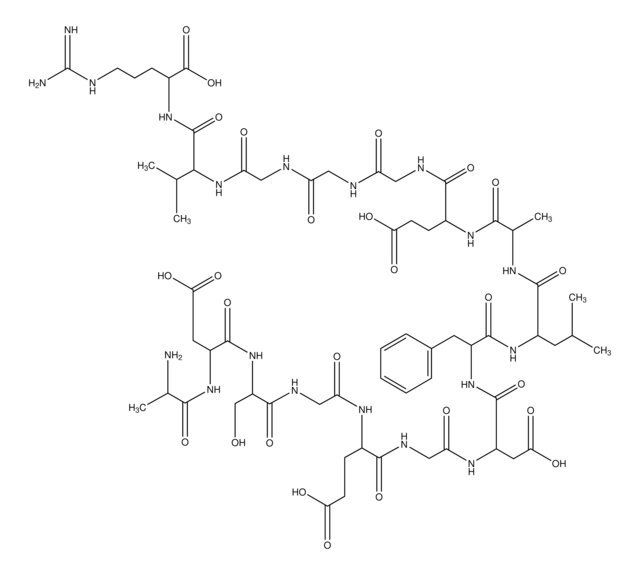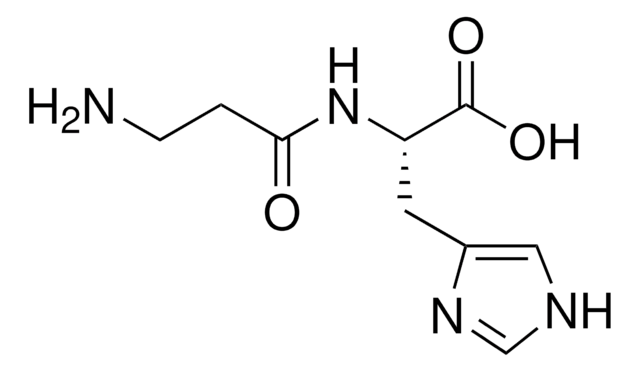F3379
Fibrinopeptide B human
≥97% (HPLC)
About This Item
Productos recomendados
biological source
human
assay
≥97% (HPLC)
form
powder
UniProt accession no.
storage temp.
−20°C
SMILES string
CC(C)C(NC(=O)CNC(=O)C1CCC(=O)N1)C(=O)NC(CC(N)=O)C(=O)NC(CC(O)=O)C(=O)NC(CC(N)=O)C(=O)NC(CCC(O)=O)C(=O)NC(CCC(O)=O)C(=O)NCC(=O)NC(Cc2ccccc2)C(=O)NC(Cc3ccccc3)C(=O)NC(CO)C(=O)NC(C)C(=O)NC(CCCNC(N)=N)C(O)=O
InChI
1S/C66H93N19O25/c1-31(2)53(85-49(91)29-73-55(99)35-16-19-47(89)75-35)64(108)83-42(26-46(68)88)61(105)82-43(27-52(96)97)62(106)81-41(25-45(67)87)60(104)78-37(18-21-51(94)95)57(101)77-36(17-20-50(92)93)56(100)72-28-48(90)76-39(23-33-11-6-4-7-12-33)58(102)80-40(24-34-13-8-5-9-14-34)59(103)84-44(30-86)63(107)74-32(3)54(98)79-38(65(109)110)15-10-22-71-66(69)70/h4-9,11-14,31-32,35-44,53,86H,10,15-30H2,1-3H3,(H2,67,87)(H2,68,88)(H,72,100)(H,73,99)(H,74,107)(H,75,89)(H,76,90)(H,77,101)(H,78,104)(H,79,98)(H,80,102)(H,81,106)(H,82,105)(H,83,108)(H,84,103)(H,85,91)(H,92,93)(H,94,95)(H,96,97)(H,109,110)(H4,69,70,71)
InChI key
MYRIFIVQGRMHRF-UHFFFAOYSA-N
Gene Information
human ... FGB(2244)
Amino Acid Sequence
General description
Biochem/physiol Actions
Storage Class
11 - Combustible Solids
wgk_germany
WGK 3
flash_point_f
Not applicable
flash_point_c
Not applicable
ppe
Eyeshields, Gloves, type N95 (US)
Elija entre una de las versiones más recientes:
¿Ya tiene este producto?
Encuentre la documentación para los productos que ha comprado recientemente en la Biblioteca de documentos.
Nuestro equipo de científicos tiene experiencia en todas las áreas de investigación: Ciencias de la vida, Ciencia de los materiales, Síntesis química, Cromatografía, Analítica y muchas otras.
Póngase en contacto con el Servicio técnico

![[Glu1]-Fibrinopeptide B human ≥90% (HPLC)](/deepweb/assets/sigmaaldrich/product/structures/122/537/7ead5c32-cb67-4325-9ce7-66c8dec24bdd/640/7ead5c32-cb67-4325-9ce7-66c8dec24bdd.png)

![[D-Ala2]-Leucine enkephalin ≥97% (HPLC)](/deepweb/assets/sigmaaldrich/product/structures/205/481/4fd123c0-14c7-4f90-8bdc-9e54a4bea7f1/640/4fd123c0-14c7-4f90-8bdc-9e54a4bea7f1.png)



